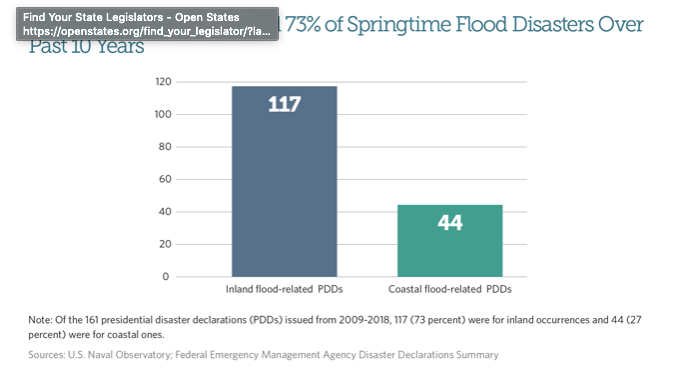
NCEL Blog
Natural Solutions to Combat Rising Rivers
May 8, 2019
The resilience of coastal communities is often at the forefront of discussions around climate change and extreme weather. However, multiple annual severe flooding events in states like Iowa and Illinois have proven that inland states are a crucial part of this conversation as well. In fact, research out of the Federal Emergency Management Agency has shown that in the last 10 years, 73% of springtime flood disasters have occurred in inland states.
This year is no exception.
- A broken levee in Davenport this April resulted in over six feet of flooding in the city’s downtown area.
- Memphis reached its fourth-highest river height ever recorded in February.
- Louisiana’s Bonnet Carre Spillway – designed to divert river flow into New Orleans’ Lake Pontchartrain – was opened earlier this year, marking the first time in its 124 year history that it was opened in back-to-back years.
Given this barrage of flooding, states along rivers are looking to implement flood mitigation and adaptation practices beyond their existing built (“gray”) infrastructure. River states have relied on gray infrastructure like dams and levees to control their flooding since the end of the 19th century. But both inland and coastal states recognize that long-term flood resilience will require a more comprehensive approach. As a result, a variety of bills have been introduced to bolster natural solutions, or green infrastructure, to flooding.
Wetlands
Wetlands are perhaps the best example of green infrastructure, as they work like sponges to soak up and slow down water flows to ultimately prevent flooding. Beyond flood mitigation, these powerhouse ecosystems provide a long list of environmental and economic benefits such as improving water quality through filtration, providing habitat for endangered species, and increasing tourism.
This year, states all across the country have introduced bills to protect or enhance their existing wetlands. Some of these bills, such as New York’s A 2524, integrate wetland protection into a larger flood mitigation and resilience package. Others are dedicated entirely to wetlands management, such as Illinois’ Wetlands Protection Act (SB 1352). This bill outlines extensive wetlands protection measures, from classifying wetlands under protection, establishing a permitting system for activities on or near wetlands, and creating a Wetlands Advisory Committee to develop recommendations.
Soil Health as a Tool for Flood and Farm Resilience
Another natural solution that both mitigates floods and improves farm resilience is healthy soil. While unhealthy soil acts as an impervious surface and enables runoff, healthy soil acts similar to wetlands and soaks up water. In fact, in a 2017 report published by the Union of Concerned Scientists, improving soil health could minimize runoff and flood frequency by 20% and make over 15% more water available for crops to use during droughts. Since flooding in Iowa alone will equate to roughly $2 billion in farm losses this year, solutions that integrate flood adaptation with agricultural benefits are essential.
Cover crops, crop rotations, and no-till practices are among some of the numerous conservation practices that improve soil health. This year, states have sought to incentivize implementation of sustainable farm practices largely through grant programs.
New Mexico, for example, introduced its Healthy Soil Act, which would fund outreach, education, and training for on-farm conservation practices, and would have created a grant program to advance soil health stewardship.
Minnesota also introduced a bill this year that takes a slightly different approach by offering financial and technical assistance to farmers already enrolled in the conservation reserve grant program under the Farm Bill.
Stakeholder Collaboration as Another Key to Community Resilience
As of this week, parts of Illinois and Iowa have maintained their peak flood stage for over one month, an unprecedented level of flooding that experts say is likely to continue into June. Given the volatile and increasingly worse nature of flooding along the Mississippi River, strategic planning and collaboration are key to finding solutions that best suit a community’s needs.
Through legislation, coastal states like Maine, New Hampshire, and California have created “coastal hazard committees,” working groups dedicated to strategizing around infrastructure and management practices to best deal with flooding. These committees produce studies, engage the public, develop policy recommendations, allocate funding, and offer a potential blueprint for collaboration that river corridor legislators could implement in their own states.
In an effort to bring legislative solutions like these to legislators along the Mississippi River, NCEL created the Mississippi River Legislative Caucus (MRLC). The goal of the Caucus is to increase legislators’ capacities to address river health and resilience issues, and to foster collaboration between legislators from all 10 corridor states, river mayors, members of Congress, advocacy groups, and the business community.
